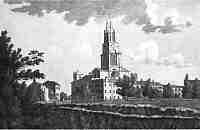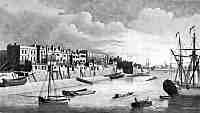In records dating far back into the fifteenth century references are found to this locality which is described as Lymehostes and Limeostez, indicating that the name of Limehouse is derived from the lime-kilns which were then in existence, and formed a distinguishing feature on the north bank of the Thames in what must have been a lonely spot in the bight of the river adjacent to a region of desolation, that watery waste known afterwards as the Isle of Dogs. The word 'oast' is still given to those quaint buildings in Kent and Surrey, the hop-kilns, that are in the common speech of their neighbourhood spoken of, in the plural, as 'oasties.' The suggestion that the name was corrupted from Limehurst - a form it assumed at one time - and that it originated from the presence of a number of lime trees may be dismissed from serious consideration on account of the improbability that in so early a period this variety of tree, so quick in growth and in decay, was planted hereabouts either for its beauty or for its value as timber.
The little hamlet which came into existence through the settlement of a number of people occupied in burning chalk for the production of lime, to be used principally in plastering wooden buildings, has in the course of time given its name to a populous parish that has passed it on to a special style of political oratory, and has associated it with a particularly romantic form of fiction orientated by a fertile imagination. Thus Limehouse, which has been so well advertised, receives some attention from the outside world more curious than itself, and tourists who are induced to visit the place with hopes of viewing strange sights, have to return with the feeling that they have only just missed that which they thought they might see in a place which has been so grotesquely exploited.
Limehouse has the fate of suffering from misrepresentation, and the allusion by Shakespeare to 'the Limbs of Limehouse' has been unfortunately misread and misquoted in a recently published account of the parish, and made to apply to a conjectured rough and disorderly riverside element for which there is indeed no justification. The passage refers to the 'dear friends of Tribulation of Tower Hill' - an obscure allusion to what was probably an assembly of persons religiously inclined with Puritanical views, and being quiet and patient in their lives. This is mentioned in order to clear away the imputation which has been cast upon, it is hoped, a highly respectable local juvenile population in Tudor days.
Until the construction of the Commercial Road, 1803-1810, Limehouse had been ill-provided with means of communication by road. The principal ways inland were those afforded by two lanes, one in the direction of Stepney Church by Salmon Lane, and the other leading to White Horse Street by Rose Lane. In some old maps Salmon Lane is shown as Sermon Lane, and it may be that as the way was long and tedious to the old Parish Church, the variation of the name naturally suggested itself. Along the river frontage, Narrow Street formed the connection with Ratcliff. To the inhabitants of Limehouse the absence of facilities for transport was a matter of small account inasmuch as their occupations and their interests were closely associated with the waterside, and the Thames was their real highway. A waterman was always at hand at Dukes Shore and Kidney Stairs to convey fares up, down, and across the river. It 1799, the greater portion of the area which formed the parish was open land. Indeed, as recently as seventy years ago, some of the rural characteristics still remained. It was not until 1862 that Burdett Road, named after Baroness Burdett-Coutts, was cut through the fields, where for centuries cattle and horses had grazed. The coming there of brickmakers was the token of the forthcoming change which took but a few years to complete.
The parish was created in 1729, and for ecclesiastical purposes included a part of the hamlet of Ratcliff that lay eastwards of Whitehorse Street, Butcher Row and Ratcliff Cross, in fact the site of London Field to which reference has been made. This was on account of the smallness of Limehouse proper, for the new parish in its entirety only consisted of about a thousand houses. The Ratcliff portion of the parish was, in 1841, attached to the newly constituted parish of St. James's, Ratcliff.
 The
picture of Limehouse Church [left] shows its appearance before the making of Commercial
Road, and were it not for the familiar look of the tower, identification would be difficult
because of its surroundings. The dedication of the church to St. Anne is said to have been suggested
as a compliment to Queen Anne. The foundation-stone was laid in 1712, and the edifice was completed
in 1724, but was not consecrated until September 1730 - that is, after the formation of the
parish. It was built of Portland stone, and designed by Nicholas Hawksmoor, a pupil of Wren.
The tower has received the admiration of several generations, despite the adverse criticism
of a few persons. From all points of view, it rises above the low surrounding buildings with
a gracious and monumental aspect.
The
picture of Limehouse Church [left] shows its appearance before the making of Commercial
Road, and were it not for the familiar look of the tower, identification would be difficult
because of its surroundings. The dedication of the church to St. Anne is said to have been suggested
as a compliment to Queen Anne. The foundation-stone was laid in 1712, and the edifice was completed
in 1724, but was not consecrated until September 1730 - that is, after the formation of the
parish. It was built of Portland stone, and designed by Nicholas Hawksmoor, a pupil of Wren.
The tower has received the admiration of several generations, despite the adverse criticism
of a few persons. From all points of view, it rises above the low surrounding buildings with
a gracious and monumental aspect.
On the morning of Good Friday, 29 March 1850, at seven o'clock, the church was discovered to be on fire and the whole neighbourhood was aroused by the ringing of the bells giving the alarm, but owing to the shortage of water little could be done to save the body of the building. In three hours there was nothing left standing but the tower. The edifice had been insured for £5,000 only from the previous January, when the first premium of £13 4s. 8d. had been paid. The balance cost of restoration, estimated as £13,000 was sought to be raised by a church rate, but the opposition to the proposal caused it to be abandoned, and the balance of the amount required was raised by voluntary subscription.
Coming back to the riverside hamlet that was the core of the parish, it may be said that during the period of England's rise to maritime power it played its part. From this little place big hearts with high hopes went in quest of trade overseas, and here small vessels of about 160 tons were built for perilous voyages. But the principal industries carried on here in the eighteenth century were those of rope-making, sail-making, barge-building, rigging and mast-making. A quantity of timber, tar, pitch, masts, and other inflammable material was landed here and stacked near the foreshore in Narrow Street, because of there being few buildings in the vicinity to be involved in fire, which was always a dreaded occurrence.
 On
[the right, the] picture shows a view of Limehouse in 1751. The buildings abutting
on the river afford a good idea of the wharves and landing-places for goods in those days.
On
[the right, the] picture shows a view of Limehouse in 1751. The buildings abutting
on the river afford a good idea of the wharves and landing-places for goods in those days.
These references to things bygone are but a few of many, and mention of well-known persons associated with the history of old Limehouse must be deferred until some future occasion.
by Sydney Maddocks
